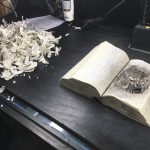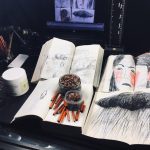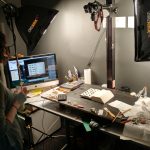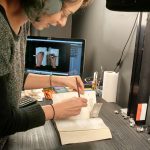Interpreting poetry can be tricky. It can be tempting to put too fine a point on things, be too overt, too definite and fail to separate and filter out opinion. It’s even more of a task to interpret a poetic text visually.
That’s what makes the way filmmakers Anna Samo and Lisa LaBracio manage to strike such a delicate balance in “The Opposites Game” truly remarkable. They not only succeed in capturing the essence of the source material without getting too literal, but also masterfully convey their perspective without veering into preachiness.
Adapted from a poem by Brendan Constantine (who also provides the narration), the short is part of the “There’s a Poem for That” series under TED’s youth and education initiative, Ted-Ed. The story unfolds as a teacher takes a line from Emily Dickinson, “My life had stood a loaded gun,” and sets his students on a quest to discover antonyms for each word. It’s a clever way to spark contemplation about poetry and its intricate layers of meaning. However, when the students can’t agree on the opposite of “gun,” it sets off a verbal skirmish that eventually leads to profound and thought-provoking insights about the power of words and their impact on the world.
“The poem began with a line from Emily Dickinson,” LaBracio told us, “so we wanted to use Emily Dickinson as our starting point, as well.” The film was made inside of nine identical copies of a book of Dickinsons poems. “In the filmmaking process, we used acrylic paint to white out the text, charcoal pencils for line work, and pastels to any bits of color.”
Further describing the somewhat meta process, LaBracio continued, “All of the other materials that appeared on screen came from the book of poetry, or from the process of creating the film itself. Crumpled or torn pages, charcoal pencil shavings, graphite remnants and even elements of sound taken from the studio were all featured, as one abstract layer was added, and then another.
“We shot the film in Dragonframe, so we used onion skinning to see where our last frame was, and where to draw the next– we often had our eyes on the screen as we drew, instead of on the book itself!”
When asked about the challenges involved with this kind of interpretation, LaBracio told us, “Our biggest challenge was, first of all, working with another artist’s poetry, and figuring out how to add to Brendan’s work without taking something away from it. We had to stay simple and clear, while not losing the poetry. We decided early that we wanted to work intuitively, letting the film grow in the process, without planning too much, so we were figuring out the details and meaning while making the animation.
“We didn’t follow the structure of making a storyboard and making the animatic designs and then animating. We would do some tests under the camera, then we would put the tests into Premiere Timeline with Brendan’s voiceover. Then, we would go into Photoshop and do some quick storyboarding and import it into the animatic, and then go back to the table and do some animation. So it was a constant back and forth, a constant conversation between the two of us, which felt very organic for animating the poem.”
Of course there were technical challenges as well, it wouldn’t be stop motion without them… “like books having different colors of white paper,” LaBracio said, “or making the movement of the pages, or the fact that as we were approaching the end of each book it would lay differently, because it would become thicker on one side then on the other.
“We used a lot of fun tack, duplo blocks and cardboard attached to shells to hold the pages in different positions etc. and we also discovered that stop motion was very forgiving – it did not have to be perfect. There was also a challenge of bringing the variety into the transitions, because we felt it would be boring to just turn pages to come from one scene to another for more than four minutes. This made us think of the different ways of using the book as a canvas and explore its depth as well, turning it around for the theater scene, crumbling the pages, cutting into them.”
According to the filmmaker, perhaps the most difficult part came at the very end of the film, which, like the poem, concludes with the line, ‘Your death will sit through many empty poems’. “The whole poem builds up to this last sentence, and emotionally you understand exactly what it means, but you can’t put it into words.
“So we were searching for a solution and we were also running out of time. And, really in an act of desperation, Anna tried cutting to the moment where we white out the poems and it just clicked. It was this last piece of the puzzle that suddenly fell into place. These are empty poems and you don’t have to say anything. This is just what it has to be.” As viewers, it does not seem the film could end in any other way–it works so perfectly, so it’s always interesting to hear where artists have struggled and come out triumphant.
The film enjoyed a 2-year festival run following its release, and lives on TED-Ed’s YouTube channel, though it also continues to be featured in a number of screenings each year since.
For more on the production, check out the bts images below:





